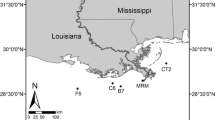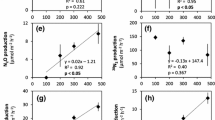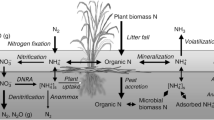Abstract
Sediments have an important role in nutrient dynamics by providing sites for denitrification, which, in conjunction with nitrogen (N) fixation and other processes such as dissimilatory nitrate reduction to ammonium (DNRA), can regulate ecosystem N availability. Little Lagoon, Alabama, USA, is affected by anthropogenic perturbations and has N inputs from nitrate (NO3 −)-contaminated submarine groundwater discharge. N cycle pathways (N-fixation, denitrification, anammox, and DNRA) and benthic fluxes were measured at three sites over a year to investigate the hypothesis that DNRA, by producing ammonium (NH4 +) as a dissimilatory end product of NO3 − reduction, was a significant process retaining bioavailable fixed N in Little Lagoon. DNRA was found to be an important NO3 − reduction pathway, especially in the summer months (study average: 52.1 μmol N m−2 h−1) compared to denitrification (study average 7.7 μmol N m−2 h−1). Sulfidic sediments during the majority of the year interfere with denitrification and result in decreased N loss through denitrification. The conversion of NO3 − to the more biologically preferred form of N, NH4 + via DNRA, means that NO3 − reduction has considerable nourishing potential and likely will affect both ecosystem function and services. These results indicate that NO3 − reduction may contribute to, rather than counteract, eutrophication during warm summers in estuaries receiving high N inputs. As estuarine sediments provide a key ecosystem function of N removal, excess anthropogenic N input jeopardizes their ability to effectively remove reactive N in Little Lagoon and likely in other impacted ecosystems.




Similar content being viewed by others
References
Aelion C, Warttinger U (2010) Sulfide inhibition of nitrate removal in coastal sediments. Estuaries Coasts 33(3):798–803
An SM, Gardner WS (2002) Dissimilatory nitrate reduction to ammonium (DNRA) as a nitrogen link, versus denitrification as a sink in a shallow estuary (Laguna Madre/Baffin Bay, Texas). Mar Ecol-Prog Ser 237:41–50
An SM, Gardner WS, Kana T (2001) Simultaneous measurement of denitrification and nitrogen fixation using isotope pairing with membrane inlet mass spectrometry analysis. Appl Environ Microbiol 67(3):1171–1178
Baron JS, Hall EK, Nolan BT, Finlay JC, Bernhardt ES, Harrison JA, Chan F, Boyer EW (2013) The interactive effects of excess reactive nitrogen and climate change on aquatic ecosystems and water resources of the United States. Biogeochemistry 114(1–3):71–92
Bernard R, Mortazavi B, Wang L, Ortmann A, MacIntyre H, Burnett W (2014) Benthic nutrient fluxes and limited denitrification in a sub-tropical groundwater-influenced coastal lagoon. Mar Ecol Prog Ser 504:13–26
Boyer JN, Fourqurean JW, Jones RD (1999) Seasonal and long-term trends in the water quality of Florida Bay (1989–1997). Estuaries 22(2B):417–430
Boynton WR, Kemp WM (1985) Nutrient regeneration and oxygen consumption by sediments along an estuarine salinity gradient. Mar Ecol Prog Ser 23:45–55
Brunet RC, Garcia-Gil LJ (1996) Sulfide-induced dissimilatory nitrate reduction to ammonia in anaerobic freshwater sediments. FEMS Microbiol Ecol 21:131–138
Burgin AJ, Hamilton SK (2007) Have we overemphasized the role of denitrification in aquatic ecosystems? A review of nitrate removal pathways. Front Ecol Environ 5(2):89–96
Burow KR, Nolan BT, Rupert MG, Dubrovsky NM (2010) Nitrate in groundwater of the United States, 1991–2003. Environ Sci Technol 44(13):4988–4997
Borum J, Sand-Jensen K (1996) Is total primary production in shallow coastal marine waters stimulated by nitrogen loading? Oikos 76:406–410
Canion A, Kostka J, Gihring T, Huettel M, Jv Beusekom, Gao H, Lavik G, Kuypers M (2013) Temperature response of denitrification and anammox reveals the adaptation of microbial communities to in situ temperatures in permeable marine sediments that span 50∞ in latitude. Biogeosci Discuss 10(9):14595–14626
Capone DG (1993) Determination of nitrogenase activity in aquatic samples using the acetylene reduction procedure. In: Kemp PF, Sherr BF, Sherr EB, Cole JJ (eds) Handbook of methods in aquatic microbiology. Lewis, Boca Raton, pp 621–631
Christensen PB, Rysgaard S, Sloth NP, Dalsgaard T, Schwaerter S (2000) Sediment mineralization, nutrient fluxes, denitrification and dissimilatory nitrate reduction to ammonium in an estuarine fjord with sea cage trout farms. Aquat Microb Ecol 21(1):73–84
Codispoti LA (2010) Interesting times for marine N2O. Science 327(5971):1339–1340
Cornwell JC, Kemp WM, Kana TM (1999) Denitrification in coastal ecosystems: methods, environmental controls, and ecosystem level controls, a review. Aquat Ecol 33:41–54
Cowan JLW, Pennock JR, Boynton WR (1996) Seasonal and interannual patterns of sediment-water nutrient and oxygen fluxes in Mobile Bay, Alabama (USA): regulating factors and ecological significance. Mar Ecol Prog Ser 141:229–245
Dalsgaard T, Thamdrup B (2002) Factors controlling anaerobic ammonium oxidation with nitrite in marine sediments. Appl Environ Microbiol 68(8):3802–3808
Dalsgaard T, Thamdrup B, Canfield DE (2005) Anaerobic ammonium oxidation (anammox) in the marine environment. Res Microbiol 156(4):457–464
Delwiche CC (1970) The nitrogen cycle. Sci Am 223:136–146
Dong LF, Smith CJ, Papaspyrou S, Stott A, Osborn AM, Nedwell DB (2009) Changes in benthic denitrification, nitrate ammonification, and anammox process rates and nitrate and nitrite reductase gene abundances along an estuarine nutrient gradient (the Colne estuary, United Kingdom). Appl Environ Microbiol 75(10):3171–3179
Dong LF, Sobey MN, Smith CJ, Rusmana I, Phillips W, Stott A, Osborn AM, Nedwell DB (2011) Dissimilatory reduction of nitrate to ammonium, not denitrification or anammox, dominates benthic nitrate reduction in tropical estuaries. Limnol Oceanogr 56(1):279–291
Dowling CB, Poreda RJ, Hunt AG, Carey AE (2004) Ground water discharge and nitrate flux to the Gulf of Mexico. Ground Water 42(3):401–417
Dunn RJK, Welsh DT, Jordan MA, Waltham NJ, Lemckert CJ, Teasdale PR (2012) Benthic metabolism and nitrogen dynamics in a sub-tropical coastal lagoon: microphytobenthos stimulate nitrification and nitrate reduction through photosynthetic oxygen evolution. Estuar Coast Shelf Sci 113:272–282
Eyre B, Rysgaard S, Dalsgaard T, Christensen PB (2002) Comparison of isotope pairing and N2:Ar methods for measuring sediment denitrification, assumption, modifications, and implications. Estuaries 25(6):1077–1087
Ferguson A, Eyre B, Gay J, Emtage N, Brooks L (2007) Benthic metabolism and nitrogen cycling in a sub-tropical coastal embayment: spatial and seasonal variation and controlling factors. Aquat Microb Ecol 48(2):175–195
Fulweiler R, Nixon S, Buckley B (2010) Spatial and temporal variability of benthic oxygen demand and nutrient regeneration in an anthropogenically impacted New England estuary. Estuaries Coasts 33(6):1377–1390
Galloway JN, Aber JD, Erisman JW, Seitzinger SP, Howarth RW, Cowling EB, Cosby BJ (2003) The nitrogen cascade. Bioscience 53(4):341–356
Galloway JN, Dentener FJ, Capone DG, Boyer EW, Howarth RW, Seitzinger SP, Asner GP, Cleveland CC, Green PA, Holland EA, Karl DM, Michaels AF, Porter JH, Townsend AR, Vöosmarty CJ (2004) Nitrogen cycles: past, present, and future. Biogeochemistry 70(2):153–226
Gardner W, McCarthy M (2009) Nitrogen dynamics at the sediment–water interface in shallow, sub-tropical Florida Bay: why denitrification efficiency may decrease with increased eutrophication. Biogeochemistry 95(2):185–198
Gardner WS, McCarthy MJ, An S, Sobolev D (2006) Nitrogen fixation and dissimilatory nitrate reduction to ammonium (DNRA) support nitrogen dynamics in Texas estuaries. Limnol Oceanogr 51(1, part 2):558–568
Giblin A, Weston N, Banta G, Tucker J, Hopkinson C (2010) The effects of salinity on nitrogen losses from an oligohaline estuarine sediment. Estuaries Coasts 33(5):1054–1068
Giblin A, Tobias C, Song B, Weston N, Banta G, Rivera-Monroy V (2013) The importance of dissimilatory nitrate reduction to ammonium (DNRA) in the nitrogen cycle of coastal ecosystems. Oceanography 26(3):124–131
Gihring TM, Canion A, Riggs A, Huettel M, Kostka JE (2010a) Denitrification in shallow, sublittoral Gulf of Mexico permeable sediments. Limnol Oceanogr 55(1):43–54
Gihring TM, Lavik G, Kuypers MMM, Kostka JE (2010b) Direct determination of nitrogen cycling rates and pathways in Arctic fjord sediments (Svalbard, Norway). Limnol Oceanogr 55(2):740–752
Goldstein T, Mazet JAK, Zabka TS, Langlois G, Colegrove KM, Silver M, Bargu S, Van Dolah F, Leighfield T, Conrad PA, Barakos J, Williams DC, Dennison S, Haulena M, Gulland FMD (2008) Novel symptomatology and changing epidemiology of domoic acid toxicosis in California sea lions (Zalophus californianus): an increasing risk to marine mammal health. Proc R Soc B 275(1632):267–276
Hardy RWF, Burns RC, Holsten RD (1973) Applications of the acetylene-ethylene assay for measurement of nitrogen fixation. Soil Biol Biochem 5:47–81
Harvell CD, Kim K, Burkholder JM, Colwell RR, Epstein PR, Grimes DJ, Hofmann EE, Lipp EK, Osterhaus ADME, Overstreet RM, Porter JW, Smith GW, Vasta GR (1999) Emerging marine diseases–climate links and anthropogenic factors. Science 285(5433):1505–1510
Holmes RM, McClelland JW, Sigman DM, Fry B, Peterson BJ (1998) Measuring 15N-NH4 + in marine, estuarine and fresh waters: an adaptation of the ammonia diffusion method for samples with low ammonium concentrations. Mar Chem 60(3–4):235–243
Hou L, Liu M, Carini SA, Gardner WS (2012) Transformation and fate of nitrate near the sediment-water interface of Copano Bay. Cont Shelf Res 35:86–94
Howarth RW (1984) The ecological significance of sulfur in the energy dynamics of salt marsh and coastal marine sediments. Biogeochemistry 1(1):5–27
Howarth RW (1988) Nutrient limitation of net primary production in marine ecosystems. Annu Rev Ecol Syst 19:89–110
Howarth R, Marino R, Cole J (1988) Nitrogen fixatin in freshwater, estuarine, and marine ecosystems. Limnol Oceanogr 33:688–701
Howarth RW, Swaney DP, Boyer EW, Marino R, Jaworski N, Goodale C (2002) Nitrogen use in the United States from 1961-2000 and potential future trends. Ambio 31:88–96
Joye SB, Hollibaugh JT (1995) Influence of sulfide inhibition of nitrification on nitrogen regeneration in sediments. Science 270:623–625
Kana TM, Sullivan MB, Cornwell JC, Groszkowski KM (1998) Denitrification in estuarine sediments determined by membrane inlet mass spectrometry. Limnol Oceanogr 43(2):334–339
Kelly-Gerreyn BA, Trimmer M, Hydes DJ (2001) A diagenetic model discriminating denitrification and dissimilatory nitrate reduction to ammonium in a temperate estuarine sediment. Mar Ecol Prog Ser 220:33–46
Koeve W, Kähler P (2010) Heterotrophic denitrification vs. autotrophic anammox–quantifying collateral effects on the oceanic carbon cycle. Biogeosciences 7(8):2327–2337
Koop-Jakobsen K, Giblin A (2010) The effect of increased nitrate loading on nitrate reduction via denitrification and DNRA in salt marsh sediments. Limnol Oceanogr 55(2):789–802
Kraft B, Tegetmeyer HE, Sharma R, Klotz MG, Ferdelman TG, Hettich RL, Geelhoed JS, Strous M (2014) The environmental controls that govern the end product of bacterial nitrate respiration. Science 345(6197):676–679
Lam P, Kuypers MMM (2011) Microbial nitrogen cycling processes in oxygen minimum zones. Annu Rev Mar Sci 3(1):317–345
Lam P, Lavik G, Jensen MM, van de Vossenberg J, Schmid M, Woebken D, Gutiérrez D, Amann R, Jetten MS, Kuypers MM (2009) Revising the nitrogen cycle in the Peruvian oxygen minimum zone. Proc Natl Acad Sci 106(12):4752–4757
Lansdown KMT, Heppell CM, Sgouridis F, Ullah S, Heathwaite AL, Binley A, Zhang H (2012) Characterization of the key pathways of dissimilatory nitrate reduction and their response to complex organic substrates in hyporheic sediments. Limnol Oceanogr 57(2):387–400
Lavrentyev PJ, Gardner WS, Yang L (2000) Effects of the zebra mussel on nitrogen dynamics and the microbial community at the sediment-water interface. Aquat Microb Ecol 21:187–194
Lehrter JC (2006) Effects of land use and land cover, stream discharge, and interannual climate on the magnitude and timing of nitrogen, phosphorus, and organic carbon concentrations in three coastal plain watersheds. Water Environ Res 78(12):2356–2368
Liefer JD, MacIntyre HL, Novoveská L, Smith WL, Dorsey CP (2009) Temporal and spatial variability in Pseudo-nitzschia spp. in Alabama coastal waters: a “hot spot” linked to submarine groundwater discharge? Harmful Algae 8(5):706–714
Liefer JD, MacIntyre HL, Su N, Burnett WC (2013a) Seasonal alternation between groundwater discharge and benthic coupling as nutrient sources in a shallow coastal lagoon. Estuaries Coasts 2013:1–16
Liefer JD, Robertson A, MacIntyre HL, Smith WL, Dorsey CP (2013b) Characterization of a toxic Pseudo-nitzschia spp. bloom in the Northern Gulf of Mexico associated with domoic acid accumulation in fish. Harmful Algae 26:20–32
McCarthy M, Lavrentyev P, Yang L, Zhang L, Chen Y, Qin B, Gardner W (2007) Nitrogen dynamics and microbial food web structure during a summer cyanobacterial bloom in a subtropical, shallow, well-mixed, eutrophic lake (Lake Taihu, China). Hydrobiologia 581(1):195–207
McCarthy MJ, McNeal KS, Morse JW, Gardner WS (2008) Bottom-water hypoxia effects on sediment-water interface nitrogen transformations in a seasonally hypoxic, shallow bay (Corpus Christi Bay, TX, USA). Estuaries Coasts 31(3):521–531
McGlathery KJ (2001) Macroalgal blooms contribute to the decline of seagrass in nutrient-enriched coastal waters. J Phycol 37(4):453–456
Mortazavi B, Iverson RL, Huang W, Lewis FG, Caffrey JM (2000) Nitrogen budget of Apalachicola Bay, a bar-built estuary in the northeastern Gulf of Mexico. Mar Ecol Prog Ser 195:1–14
Mulholland PJ, Helton AM, Poole GC, Hall RO, Hamilton SK, Peterson BJ, Tank JL, Ashkenas LR, Cooper LW, Dahm CN, Dodds WK, Findlay SEG, Gregory SV, Grimm NB, Johnson SL, McDowell WH, Meyer JL, Valett HM, Webster JR, Arango CP, Beaulieu JJ, Bernot MJ, Burgin AJ, Crenshaw CL, Johnson LT, Niederlehner BR, O’Brien JM, Potter JD, Sheibley RW, Sobota DJ, Thomas SM (2008) Stream denitrification across biomes and its response to anthropogenic nitrate loading. Nature 452(7184):202–205
Murgulet D, Tick GR (2008) Assessing the extent and sources of nitrate contamination in the aquifer system of southern Baldwin County, Alabama. Environ Geol 58(5):1051–1065
Nicholls JC, Trimmer M (2009) Widespread occurrence of the anammox reaction in estuarine sediments. Aquat Microb Ecol 55:105–113
Nielsen LP (1992) Denitrification in sediment determined from nitrogen isotope pairing. FEMS Microbiol Ecol 86(4):357–362
Nixon S (1995) Coastal marine eutrophication: a definition, social causes, and future concerns. Ophelia 41:199–219
Piehler MF, Smyth AR (2011) Habitat-specific distinctions in estuarine denitrification affect both ecosystem function and services. Ecosphere 2(1):art12
Porubsky WP, Weston NB, Joye SB (2009) Benthic metabolism and the fate of dissolved inorganic nitrogen in intertidal sediments. Estuar Coast Shelf Sci 83(4):392–402
Rabalais NN (2002) Nitrogen in aquatic ecosystems. AMBIO 31(2):102–112
Rabalais NN, Turner RE, Wiseman WJ (2002) Gulf of Mexico hypoxia, A.K.A. “the Dead Zone”. Annu Rev Ecol Syst 33(1):235–263
Risgaard-Petersen N, Nielsen LP, Rysgaard S, Dalsgaard T, Meyer RL (2003) Application of the isotope pairing technique in sediments where anammox and denitrification coexist. Limnol Oceanogr 1:63–73
Robertson GP, Bruulsema T, Gehl R, Kanter D, Mauzerall D, Rotz CA, Williams C (2013) Nitrogen-climate interactions in US agriculture. Biogeochemistry 114(1–3):41–70
Schlesinger WH (2009) On the fate of anthropogenic nitrogen. Proc Natl Acad Sci USA 106(1):203–208
Schlesinger WH, Reckhow KH, Bernhardt ES (2006) Global change: the nitrogen cycle and rivers. Water Resour Res 42:W03S06
Seitzinger SP (1988) Denitrification in freshwater and coastal marine ecosystems: ecological and geochemical significance. Limnol Oceanogr 33:702–724
Smyth A, Thompson S, Siporin K, Gardner W, McCarthy M, Piehler M (2013) Assessing nitrogen dynamics throughout the estuarine landscape. Estuaries Coasts 36(1):44–55
Sørensen J (1978) Denitrification rates in a marine sediment as measured by the acetylene inhibition technique. Appl Environ Microbiol 36:139–143
Stark JM, Hart SC (1996) Diffusion technique for preparing salt solutions, Kjeldahl digests, and persulfate digests for nitrogen-15 analysis. Soil Sci Soc Am J 60(6):1846–1855
Su N, Burnett WC, Eller KT, MacIntyre HL, Mortazavi B, Leifer J, Novoveská L (2012) Radon and radium isotopes, groundwater discharge and harmful algal blooms in Little Lagoon, Alabama. In: Kawaguchi M, Misaki K, Sato H, Yokokawa T, Itai T, Nguyen M, Ono J, Tanabe S (eds) Interdisciplinary studies on environmental chemistry–environmental pollution and ecotoxicology. Terrapub, Tokyo, pp 329–337
Su N, Burnett WC, MacIntyre HL, Liefer JD, Peterson RN, Viso R (2013) Natural radon and radium isotopes for assessing groundwater discharge into Little Lagoon, AL: implications for harmful algal blooms. Estuaries Coasts 2013:1–18
Suddick E, Whitney P, Townsend A, Davidson E (2013) The role of nitrogen in climate change and the impacts of nitrogen—climate interactions in the United States: foreword to thematic issue. Biogeochemistry 114(1–3):1–10
Thamdrup B, Dalsgaard T (2002) Production of N2 through anaerobic ammonium oxidation coupled to nitrate reduction in marine sediments. Appl Environ Microbiol 68(3):1312–1318
Thauer R, Jungerman K, Decker K (1977) Energy conservation in chemotrophic anaerobic bacteria. Microb Rev 41:100–180
Tobias CR, Anderson IC, Canuel EA, Macko SA (2001) Nitrogen cycling through a fringing marsh-aquifer ecotone. Mar Ecol Prog Ser 210:25–39
Todd EC (1993) Domoic acid and amnesic shellfish poisoning: a review. J Food Protect 56:69
Turner ER (1990) Landscape development and coastal wetland losses in the Northern Gulf of Mexico. Am Zool 30(1):89–105
Twilley RR, Cowan J, Miller-Way T, Montagna PA, Mortazavi B (1999) Benthic nutrient fluxes in selected estuaries in the Gulf of Mexico. In: Bianchi TS, Pennock JR, Twilley RR (eds) Biogeochemistry of Gulf of Mexico Estuaries. Wiley, New York, pp 163–209
United States Census Bureau (2011) Alabama population estimates. In: Bureau USC (ed)
Valiela I, Bowen JL (2002) Nitrogen sources to watersheds and estuaries: role of land cover mosaics and losses within watersheds. Environ Pollut 118(2):239–248
Welsh DT, Bourgues S, de Wit R, Herbert RA (1996) Seasonal variations in nitrogen-fixation (acetylene reduction) and sulphate-reduction rates in the rihizosphere of Zostera noltii: nitrogen fixation by sulphate-reducing bacteria. Mar Biol 125:619–628
Wright J, Boyd R, Freitas Ad, Falk M, Foxall R, Jamieson W, Laycock M, McCulloch A, McInnes A, Odense P (1989) Identification of domoic acid, a neuroexcitatory amino acid, in toxic mussels from eastern Prince Edward Island. Can J Chem 67(3):481–490
Zhu G, Wang S, Wang W, Wang Y, Zhou L, Jiang B, den Camp HJO, Risgaard-Petersen N, Schwark L, Peng Y (2013) Hotspots of anaerobic ammonium oxidation at land-freshwater interfaces. Nat Geosci 6(2):103–107
Acknowledgments
This work was supported by the National Science Foundation (Grant No. OCE-0962008). We thank Dennis Hatfield and Darrel Bass for access to Little Lagoon through their properties during sampling excursions. We thank Dr. John Stark at Utah State University for assistance with isotope analysis. BM was a program officer at the National Science Foundation during the writing of this article. Any opinion, findings and conclusions expressed here are those of the authors and do not necessarily reflect the views of the Foundation. We thank the anonymous reviewers for many helpful suggestions.
Author information
Authors and Affiliations
Corresponding author
Additional information
Responsible Editor: Leila J. Hamdan.
Rights and permissions
About this article
Cite this article
Bernard, R.J., Mortazavi, B. & Kleinhuizen, A.A. Dissimilatory nitrate reduction to ammonium (DNRA) seasonally dominates NO3 − reduction pathways in an anthropogenically impacted sub-tropical coastal lagoon. Biogeochemistry 125, 47–64 (2015). https://doi.org/10.1007/s10533-015-0111-6
Received:
Accepted:
Published:
Issue Date:
DOI: https://doi.org/10.1007/s10533-015-0111-6




